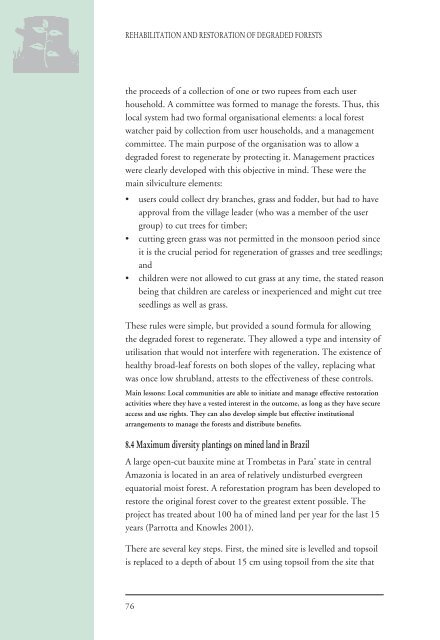Rehabilitation and Restoration Of Degraded Forests (PDF) - IUCN
Rehabilitation and Restoration Of Degraded Forests (PDF) - IUCN
Rehabilitation and Restoration Of Degraded Forests (PDF) - IUCN
Create successful ePaper yourself
Turn your PDF publications into a flip-book with our unique Google optimized e-Paper software.
REHABILITATION AND RESTORATION OF DEGRADED FORESTS<br />
the proceeds of a collection of one or two rupees from each user<br />
household. A committee was formed to manage the forests. Thus, this<br />
local system had two formal organisational elements: a local forest<br />
watcher paid by collection from user households, <strong>and</strong> a management<br />
committee. The main purpose of the organisation was to allow a<br />
degraded forest to regenerate by protecting it. Management practices<br />
were clearly developed with this objective in mind. These were the<br />
main silviculture elements:<br />
• users could collect dry branches, grass <strong>and</strong> fodder, but had to have<br />
approval from the village leader (who was a member of the user<br />
group) to cut trees for timber;<br />
• cutting green grass was not permitted in the monsoon period since<br />
it is the crucial period for regeneration of grasses <strong>and</strong> tree seedlings;<br />
<strong>and</strong><br />
• children were not allowed to cut grass at any time, the stated reason<br />
being that children are careless or inexperienced <strong>and</strong> might cut tree<br />
seedlings as well as grass.<br />
These rules were simple, but provided a sound formula for allowing<br />
the degraded forest to regenerate. They allowed a type <strong>and</strong> intensity of<br />
utilisation that would not interfere with regeneration. The existence of<br />
healthy broad-leaf forests on both slopes of the valley, replacing what<br />
was once low shrubl<strong>and</strong>, attests to the effectiveness of these controls.<br />
Main lessons: Local communities are able to initiate <strong>and</strong> manage effective restoration<br />
activities where they have a vested interest in the outcome, as long as they have secure<br />
access <strong>and</strong> use rights. They can also develop simple but effective institutional<br />
arrangements to manage the forests <strong>and</strong> distribute benefits.<br />
8.4 Maximum diversity plantings on mined l<strong>and</strong> in Brazil<br />
A large open-cut bauxite mine at Trombetas in Para’ state in central<br />
Amazonia is located in an area of relatively undisturbed evergreen<br />
equatorial moist forest. A reforestation program has been developed to<br />
restore the original forest cover to the greatest extent possible. The<br />
project has treated about 100 ha of mined l<strong>and</strong> per year for the last 15<br />
years (Parrotta <strong>and</strong> Knowles 2001).<br />
There are several key steps. First, the mined site is levelled <strong>and</strong> topsoil<br />
is replaced to a depth of about 15 cm using topsoil from the site that<br />
76

















